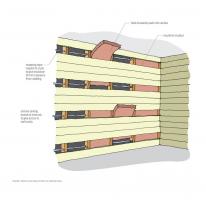House is draughty
Listed under: Interior, floor coverings, floorboards, timber and wood-based, timber, cladding, doors, floors, walls, windows
Cause
House built before 1970 and with older timber windows
Repair
-
add draught seals to windows and doors. Research by the Department of Public Health at the University of Otago in Wellington shows that fixing sealing strips to doors can help to eliminate draughts and lift indoor temperatures by an average of 1.36°C
-
adding secondary glazing to windows can give thermal benefits without the cost of replacing windows with double-glazing. Secondary glazing is often installed for the winter and removed over summer. With this, plastic film, magnetically attached plastic sheet, plain or low-E glass is installed inside the existing glass with a still air gap between the original glazing and secondary glazing. BRANZ testing found that by far the best result comes from low emissivity (low-E) secondary glazing in an aluminium frame
-
removing the existing sash and glass and modifying the timber sash to accept insulating glass units may be possible
-
replacing the timber frames with new frames and double glazing is likely to be the most expensive option.
Cause
Open fireplaces
Repair
-
block off unused open fireplaces or replace the traditional open fire with a proprietary closed firebox insert
- rental properties have particular requirements in law that are part of the healthy homes standards. In the draught stopping standard, all unused open fireplaces in rental homes must be closed off or their chimneys must be blocked to prevent draughts
-
removing old chimneys may be considered if the old fireplace is unlikely to be used again. This should be considered especially if the old lime mortar in the chimney has lost its strength and the chimney may collapse in an earthquake.
-
removal of an unsound chimney does not require building consent. This exemption to consent is limited to any building up to 3 storeys high as long as the removal does not affect the primary structure, any specified system or any fire separation (which includes firewalls protecting other property). Any necessary repair work – for example, making good the gaps left in a roof after chimney removal – can also be done without a consent. The work must still comply with the Building Code.
Cause
Gaps in floorboards
Repair
- if air is entering the house through floorboards, install underfloor insulation, with sheet lining underneath it if necessary depending on wind exposure. Under the healthy homes standards, rental properties with suspended timber ground floors must have underfloor insulation where it is reasonably practical to install it.
Cause
Wind flow through external walls
Repair
-
fix sheet linings to walls. If match lining is removed, a 9 mm timber fillet may need to be fitted to door and window jams to allow for lining thickness. However, plasterboard can be installed over match lining
-
this is a good opportunity to retrofit wall insulation. Villas and bungalows often have no dwangs in the walls, which makes installation of insulation easier. At least some of the sarking boards will need to be removed to provide access (see drawing). This method is most suitable for polyester or wool/polyester products, which are strong enough to be pulled through gaps without coming apart.
-
A building consent is required to install insulation into existing exterior walls.




